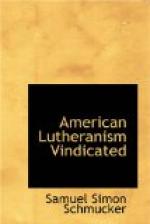In regard to the arguments against this view of the mode of the Saviour’s presence, we shall merely add an enumeration of the principal, and refer the reader for a more full and detailed discussion of the subject to Discourse IV. contained in our History of the American Lutheran Church, pp. 120 to 154, 5th edition.
The Reformers justly rejected the Romish error, that the bread and wine were transformed and transubstantiated into the body and blood of Christ. But they still adhered to the opinion, that the real body and blood of the Saviour are present at the Eucharist, in some mysterious way, and are received by the month of every communicant, worthy and unworthy. This view of the subject appears inconsistent with the Word of God, for various reasons:-
(a) When Christ uttered the words, this (bread) is my body, his body was not yet dead, but living and reclining, at their side at the table. It was therefore certainly not received by them into their mouths. The language must, therefore, have been figurative, such as Jesus was accustomed often to employ. Thus, when he said, “I am the door” John x. 9, he certainly does not mean a literal door, such as a door of wood or stone or brass or of any other material. He means that the acceptance of the atonement and mediation by the sinner is the appointed condition of salvation to him. Thus also when he says, “I am the true vine” John xv. 1; or “The field is the world,” “The seed is the word,” &c., he evidently is speaking figuratively and communicating important moral truth, by images drawn from physical nature, as is naturally done by nearly all writers and speakers of all ages and in all languages.
(b) The blessed Saviour himself exhorts us, “Do this in remembrance of me;” but we can remember only that which is past and absent. Hence when he admonishes us to do this in remembrance of him, he teaches us, that he is not personally or bodily present at the eucharistic celebration.
(c) Paul also represents the design of this ordinance to be, “To show or publish the Lord’s death,” until he comes. But the Lord’s death upon the cross occurred about eighteen hundred and twenty years ago. Therefore, according to Paul, the object of the holy supper is to commemorate a past event, and not a present person.




